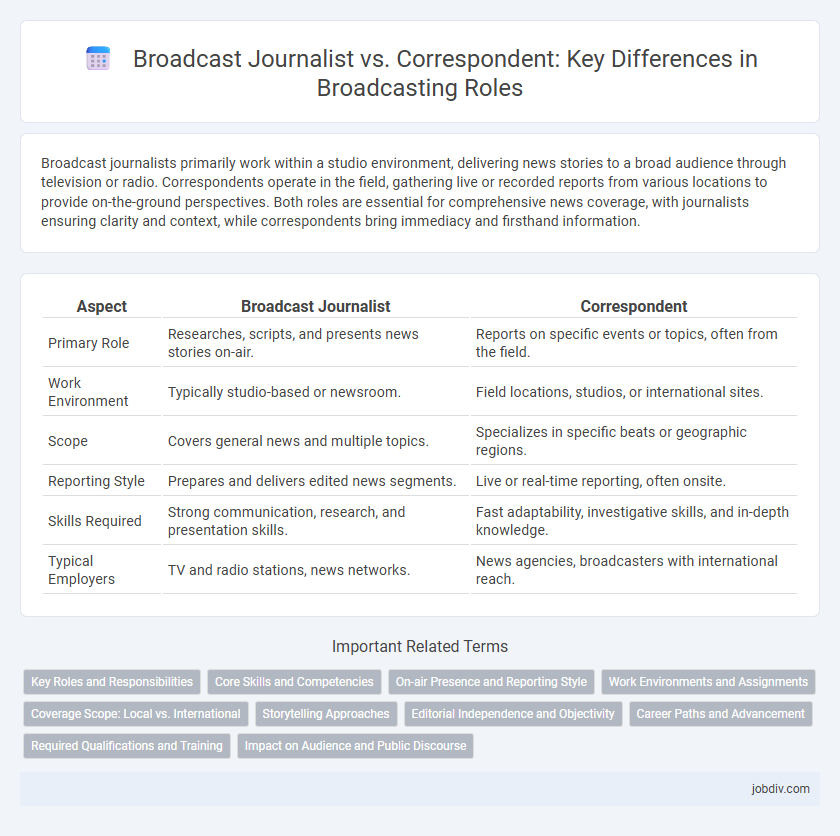Broadcast journalists primarily work within a studio environment, delivering news stories to a broad audience through television or radio. Correspondents operate in the field, gathering live or recorded reports from various locations to provide on-the-ground perspectives. Both roles are essential for comprehensive news coverage, with journalists ensuring clarity and context, while correspondents bring immediacy and firsthand information.
Table of Comparison
| Aspect | Broadcast Journalist | Correspondent |
|---|---|---|
| Primary Role | Researches, scripts, and presents news stories on-air. | Reports on specific events or topics, often from the field. |
| Work Environment | Typically studio-based or newsroom. | Field locations, studios, or international sites. |
| Scope | Covers general news and multiple topics. | Specializes in specific beats or geographic regions. |
| Reporting Style | Prepares and delivers edited news segments. | Live or real-time reporting, often onsite. |
| Skills Required | Strong communication, research, and presentation skills. | Fast adaptability, investigative skills, and in-depth knowledge. |
| Typical Employers | TV and radio stations, news networks. | News agencies, broadcasters with international reach. |
Key Roles and Responsibilities
Broadcast journalists gather, investigate, and present news stories across various media platforms, ensuring accuracy and audience engagement through live reporting and studio anchoring. Correspondents specialize in on-location reporting, often covering specific beats such as politics, war, or international affairs, providing in-depth analysis and firsthand accounts from the field. Both roles demand strong research skills and the ability to communicate complex information clearly and concisely to diverse audiences.
Core Skills and Competencies
Broadcast journalists excel in storytelling, on-camera presence, and quick adaptation to live reporting, demonstrating strong interviewing and scriptwriting abilities. Correspondents specialize in in-depth reporting from specific locations, requiring expert research skills, cultural sensitivity, and the ability to convey complex information accurately. Both roles demand excellent communication, critical thinking, and the capacity to work under tight deadlines in dynamic environments.
On-air Presence and Reporting Style
Broadcast journalists maintain a strong on-air presence by delivering news directly from the studio, prioritizing clear articulation and a neutral tone to engage a broad audience. Correspondents often report live from the field, adopting a dynamic and immersive style that provides real-time updates and vivid storytelling. Both roles require adaptability, but correspondents emphasize contextual detail and immediacy, while broadcast journalists focus on polished delivery and comprehensive coverage.
Work Environments and Assignments
Broadcast journalists typically work in newsroom studios where they gather, write, and deliver news stories to a local or national audience, focusing on diverse topics and daily news cycles. Correspondents often operate from field locations or international bureaus, covering specific beats or breaking news events with in-depth reporting and live updates. Both roles require adaptability, but correspondents face more dynamic environments involving travel and on-the-ground reporting, whereas broadcast journalists maintain consistent studio-based workflows.
Coverage Scope: Local vs. International
Broadcast journalists primarily focus on local or regional news, delivering timely reports tailored to their immediate audience's interests and concerns. Correspondents specialize in international or national coverage, often reporting from various locations worldwide to provide in-depth analysis of global events. The distinction lies in the geographic scope of their reporting, with broadcast journalists concentrating on community-level stories and correspondents addressing broader, often cross-border issues.
Storytelling Approaches
Broadcast journalists prioritize concise, clear storytelling for immediate audience impact, often presenting news directly from the studio. Correspondents employ immersive, on-the-ground storytelling techniques, providing in-depth context and firsthand accounts to enhance viewer engagement. Both roles use visual and narrative elements strategically to convey the significance and nuances of news stories effectively.
Editorial Independence and Objectivity
Broadcast journalists maintain editorial independence by producing unbiased news content, ensuring that reporting is free from external influences or organizational agendas. Correspondents often operate in specific locations or beats, balancing firsthand reporting with editorial guidelines to preserve objectivity in their coverage. Both roles uphold journalistic integrity by adhering to strict standards that separate factual reporting from opinion, fostering public trust in broadcast media.
Career Paths and Advancement
Broadcast journalists primarily work within newsrooms, producing and presenting stories for television, radio, or online platforms, with career advancement often leading to roles such as news anchors or editors. Correspondents typically specialize in field reporting, covering specific beats or international news, gaining expertise that can propel them into senior correspondent positions or bureau chief roles. Both career paths offer opportunities for specialization and leadership, but correspondents generally experience more travel and on-the-ground reporting experience.
Required Qualifications and Training
Broadcast journalists typically require a bachelor's degree in journalism, communications, or a related field, with training emphasizing news writing, reporting, and on-camera presentation. Correspondents often need specialized knowledge or experience in specific beats like politics, international affairs, or science, combined with advanced reporting skills and sometimes proficiency in multiple languages. Both roles benefit from internships, practical experience, and continuous professional development to meet industry standards and deadlines effectively.
Impact on Audience and Public Discourse
Broadcast journalists shape public understanding through in-depth reporting and storytelling that provides context and analysis, fostering informed audiences. Correspondents deliver timely, on-the-ground updates from specific locations, enhancing immediacy and credibility in news coverage. Together, their contributions influence public discourse by blending detailed narratives with real-time insights, driving engagement and awareness.
Broadcast Journalist vs Correspondent Infographic

 jobdiv.com
jobdiv.com